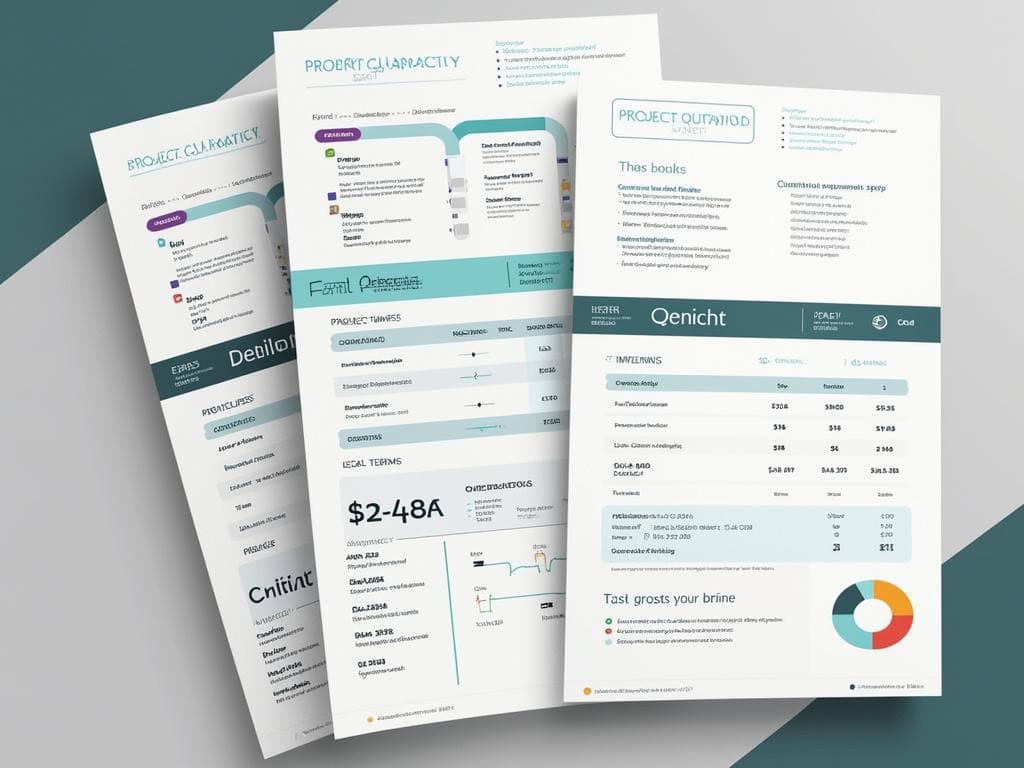
Project Quotation Formats: Essential Tools for Business Success
Project quotation formats act as comprehensive strategic business tools that outline project costs, scope, and execution conditions, setting clear expectations between businesses and clients. A well-structured project quotation format communicates financial details and serves as a roadmap for project delivery, covering critical elements like identification, pricing, timeline, and legal terms.
Key Takeaways:
- Provides a professional framework for project communication and agreement
- Includes essential elements like company information, unique quotation number, and client details
- Offers a detailed breakdown of project scope, deliverables, and associated costs
- Establishes clear timeline and milestone expectations for project execution
- Serves as a legally binding document that protects both client and service provider interests
Creating effective project scope statements requires attention to detail and precision. Your quotation needs to capture all aspects of the work while remaining clear and concise. Each component plays a specific role in ensuring both parties understand what’s being promised, when it will be delivered, and at what cost.
The format you choose directly impacts how your clients perceive your professionalism. A disorganized or incomplete quotation may raise concerns about your ability to execute the project successfully. Conversely, a carefully crafted document builds confidence and sets the stage for a productive business relationship.
Consider including visual elements such as charts or graphs to illustrate complex pricing structures or timelines. These visual aids can help clients quickly grasp important information without wading through dense text.
Legal sections deserve special attention. Terms and conditions, payment schedules, and cancellation policies need clear explanations in straightforward language. This protects your interests while giving clients the transparency they need to make informed decisions about accepting your quotation.
Digital quotation tools can streamline the creation process and allow for quick customization based on client needs. Many solutions offer templates specifically designed for different industries, helping you maintain consistency while adapting to specific project requirements.
Remember to incorporate your brand identity throughout the document. Consistent use of logos, colors, and formatting reinforces your professional image and helps your quotation stand out from competitors. This subtle marketing approach works effectively without seeming pushy.
“An effective project quotation format is not just a financial document; it serves as a strategic roadmap that aligns client expectations with project execution, ensuring clarity on scope, deliverables, and timelines. By meticulously outlining essential elements, it creates a professional framework that protects the interests of both clients and service providers, fostering a successful partnership.”
The Anatomy of an Effective Project Quotation
A well-structured project quotation format serves as your strategic business tool, establishing clear expectations between you and your client before work begins. This formal estimate doesn’t just outline costs—it communicates scope, timeline, and conditions that will govern your entire project relationship.
Creating an effective project quotation format requires attention to several key components that work together to form a comprehensive business document. Your quotation should function as both a financial proposal and a roadmap for project execution.
The foundation of any professional project quotation format begins with proper identification elements. These include:
- Your company name, logo, and complete contact information
- A unique quotation number for tracking and reference
- Issue date and validity period (typically 30-60 days)
- Client’s organization name and primary contact details
- Your relevant professional credentials or licenses
The heart of your project quotation format lies in the detailed breakdown of scope and pricing. This section should provide:
- Clear project objectives and specific deliverables
- Itemized services with individual costs
- Materials and resources required
- Labor rates and estimated hours
- Applicable taxes and potential discounts
- Comprehensive total with subtotals
Your best project timeline information provides crucial context about project execution. Include:
- Visual representation of the project schedule
- Key milestones and deliverable dates
- Phase-specific timelines with dependencies
- Resource allocation across the project lifecycle
The legal framework establishes the binding nature of your project quotation format. Never overlook:
- Detailed terms and conditions
- Payment schedule and accepted methods
- Warranty information and limitations
- Change management procedures
- Signature blocks for formal acceptance
Effective project quotation format implementation delivers significant business benefits. You’ll experience:
Benefits of a Standardized Project Quotation Format
A consistent project quotation format streamlines your business operations in several ways:
- Reduces estimation time and errors
- Creates professional client impressions
- Provides legal protection for all parties
- Facilitates faster client decision-making
- Improves project tracking and cost control
- Enhances communication between stakeholders
Using digital tools specifically designed for creating project quotations can further streamline your process. These solutions often integrate with your project management systems, allowing seamless workflow from quotation to execution.
By implementing a robust project quotation format, you establish the foundation for successful project delivery. Your detailed quotation demonstrates professionalism while protecting both your interests and your client’s through clear documentation of expectations.
Expert Insight: To craft an effective project quotation, prioritize clarity and detail in your format, ensuring it serves as both a financial proposal and a project roadmap. Include vital identification elements, a comprehensive breakdown of scope and pricing, and a clear timeline with legal terms to foster a solid client relationship. Leveraging digital tools can enhance your quotation process, leading to improved efficiency, professionalism, and client satisfaction.
Essential Header and Identification Elements
Creating an effective project quotation format starts with getting the header elements right. These identifiers serve as the foundation for your project quotation document, establishing professionalism and providing crucial reference information.
Your project quotation header should prominently display your company name, logo, and complete contact information including address, phone number, email, and website. This branding reinforces your company identity and gives clients immediate access to your contact details.
Every project quotation format requires a unique identification number for tracking purposes. This quotation number helps with internal record-keeping and provides a reference point for all future communications about the project. Include the date of issue and clearly state the validity period (typically 30, 60, or 90 days) to create urgency and protect against price fluctuations.
The client section of your project quotation format should include:
- Full client company name
- Primary contact person
- Client address and contact details
- Project location (if different from client address)
- Client reference numbers (if applicable)
Professional credentials add credibility to your project quotation format. Include relevant licenses, certifications, or professional memberships that demonstrate your qualification to perform the work. This builds trust with potential project stakeholders and can help differentiate you from competitors.
Digital Quotation Formatting Elements
Modern project quotation formats often include digital elements that enhance functionality. Consider incorporating:
- Digital signature fields for faster approval
- QR codes linking to supplementary information
- Clickable links to terms and conditions
- Interactive cost calculators
These digital elements make your project quotation format more user-friendly while supporting effective project collaboration from the start.
The following table highlights the essential header elements for your project quotation format:
| Element | Purpose | Best Practice |
|---|---|---|
| Company Information | Establishes identity | Include logo and complete contact details |
| Quotation Number | Tracking reference | Use consistent numbering system |
| Date Information | Sets timeline expectations | Include issue date and expiration date |
| Client Details | Confirms recipient | Full company name and specific contact person |
| Professional Credentials | Builds credibility | Relevant licenses and certifications |
A well-structured project quotation format helps prevent scope creep by clearly documenting all aspects of the work to be performed. This clarity protects both you and your client from misunderstandings that could lead to project delays or disputes.
Expert Insight: To create a professional project quotation, ensure your header includes your company name, logo, and complete contact details, as this establishes your identity and provides clients with immediate access to essential information. Incorporate a unique quotation number and clearly state the issue date and validity period to facilitate tracking and build urgency, helping protect against price fluctuations. Additionally, include the client’s complete information and your relevant professional credentials to enhance credibility and foster trust with potential stakeholders.
Comprehensive Project Scope and Pricing Breakdown
Creating an effective project quotation format requires attention to detail and clear organization. Your project quotation format should include a thorough breakdown of all costs and deliverables to prevent misunderstandings and scope creep later in the project.
A well-structured project quotation format serves as both a financial document and a communication tool. You’ll need to include a detailed description of project objectives that clearly outlines what you’ll deliver. This section forms the foundation of your entire quotation and helps establish clear expectations with your client.
The pricing section must be comprehensive and transparent. Here’s what you should include in your project quotation format:
- Itemized list of all services with descriptions
- Detailed breakdown of materials and resources required
- Unit prices for each component
- Quantities needed for project completion
- Individual service costs with labor rates
- Applicable taxes and regulatory fees
- Any potential discounts or special pricing
- Total cost summary with clear subtotals
Using tables in your project quotation format can effectively organize complex pricing information. Here’s an example of how you might structure a pricing table:
| Service/Item | Quantity | Unit Price | Total |
|---|---|---|---|
| Initial consultation | 10 hours | $150 | $1,500 |
| System design | 1 | $5,000 | $5,000 |
| Implementation | 1 | $8,500 | $8,500 |
| Testing | 40 hours | $125 | $5,000 |
| Subtotal | $20,000 | ||
| Tax (7%) | $1,400 | ||
| Total | $21,400 |
Advanced Elements for Comprehensive Project Quotations
Your project quotation format should also include contingency plans and assumptions. These elements help manage client expectations and protect both parties if project conditions change. When documenting project assumptions, be specific about what factors might affect pricing or delivery.
The project quotation format should clearly state payment terms, including:
- Required deposits or advance payments
- Payment schedule linked to project milestones
- Accepted payment methods
- Late payment policies and penalties
- Currency and exchange rate considerations
Including a section for client approval makes your project quotation format more formal and binding. This signature area transforms your quotation into a contractual document once signed, protecting both parties and establishing clear agreement on the project quotation format and terms.

Project Timeline and Milestone Mapping
A well-structured project quotation format requires clear timeline and milestone mapping to set realistic expectations. You’ll gain significant advantages by including detailed chronological information in your quotations, helping clients understand the project quotation format and execution schedule.
Effective project timelines within your project quotation format should include start and end dates for each phase, allowing for transparent tracking of progress. This approach helps prevent scope creep by establishing clear boundaries around project deliverables and their associated timeframes.
When mapping milestones in your project quotation format, consider breaking larger projects into manageable segments with specific completion targets. This provides natural checkpoints for both your team and stakeholders to assess progress and make adjustments as needed.
Your timeline presentation can take several forms depending on the project quotation format you prefer:
- Gantt charts showing task dependencies and parallel activities
- Simple calendar-based timelines with key deliverable dates
- Phase-specific breakdowns with allocated time periods
- Weekly or monthly progress expectations with defined outcomes
For complex projects, include resource allocation details within your project quotation format timeline. This helps clients understand how team members and materials will be distributed throughout the project duration.
Strategic Timeline Components
Include these critical elements in your project quotation format timeline section:
- Project kickoff date and preliminary planning period
- Major phase transition points with clear deliverables
- Client review and approval windows
- Buffer periods for unexpected challenges
- Final delivery and implementation dates
- Post-implementation support schedule
The project quotation format should also address potential timeline risks and contingency plans. This demonstrates effective risk response planning and builds client confidence in your approach.
Milestone mapping in your project quotation format serves as a visual roadmap that helps stakeholders understand the project’s progression. Each milestone should represent a significant achievement or deliverable that moves the project forward.
Remember that your project quotation format timeline must balance detail with clarity. Too much information can overwhelm clients, while too little can create uncertainty about project execution. The ideal project quotation format presents a comprehensive yet digestible overview of the project’s temporal structure.
By crafting thoughtful timeline and milestone maps in your project quotation format, you establish clear expectations that help prevent misunderstandings and ensure successful project delivery.
Projects with clear timelines are 30% more likely to succeed than those that do not outline their timeframe clearly.
forbes.com
Legal Framework and Binding Agreements
The legal aspects of your project quotation format serve as the foundation for a successful business relationship. A properly structured quotation isn’t just a price list—it’s a legally binding document that protects both parties throughout the project lifecycle. Ensuring your project quotation format includes comprehensive legal elements helps prevent disputes and creates a clear framework for project execution.
A well-crafted project quotation format should include detailed terms and conditions that outline the rights and responsibilities of each party. These terms serve as a mini-contract within your quotation, establishing the rules of engagement before work begins. You’ll need to address payment schedules, specifying when payments are due and the acceptable payment methods. Many effective project quotation formats include milestone-based payment structures tied to deliverable completion.
Your quotation should incorporate warranty information that clearly states what is covered, for how long, and under what conditions. This section of your project quotation format provides clients with confidence while limiting your liability to reasonable parameters. Risk management clauses are equally important, addressing potential issues like project delays, scope changes, or cancellations. Including these in your project quotation format helps establish effective risk response strategies from the outset.
Signature Requirements and Legal Protections
The signature section transforms your quotation from a proposal into a binding agreement. Your project quotation format should include:
- Clear signature blocks for both parties with dates
- Statement confirming that signatures constitute acceptance of all terms
- Designation of authorized signatories required
- Instructions for returning the signed document
- Documentation of any verbal agreements discussed during negotiations
These elements create legal protections for both parties, preventing misunderstandings about project scope and deliverables. A properly formatted signature section in your project quotation format establishes accountability and helps identify key stakeholders with decision-making authority.
The inclusion of confidentiality clauses in your project quotation format protects sensitive information shared during the project. These clauses should outline how proprietary information will be handled, stored, and eventually disposed of after project completion. Dispute resolution procedures should also be included, specifying whether mediation, arbitration, or litigation will be used to resolve conflicts. This comprehensive approach to the project quotation format creates a solid legal foundation for successful project delivery.
Strategic Benefits and Implementation
A well-structured project quotation format offers significant strategic advantages to your business operations. When implemented correctly, this vital document serves as more than just a price list—it becomes a powerful communication tool that strengthens client relationships and streamlines project management processes.
Key Strategic Advantages of Effective Project Quotations
Using a standardized project quotation format provides numerous benefits across your organization:
- Creates transparency that builds trust with clients
- Reduces scope creep by clearly defining deliverables
- Minimizes disputes through documented agreement
- Enhances cash flow predictability with clear payment terms
- Improves project collaboration through shared expectations
- Strengthens your competitive position with professional presentation
- Supports better capacity planning across your project portfolio
The ideal project quotation format includes all cost elements, scope details, timelines, and terms in a structured template. This comprehensive approach helps prevent misunderstandings that can derail projects later.
To implement an effective quotation system in your organization, follow these practical steps:
- Create a standardized project quotation format template
- Train your team on proper quotation development
- Establish an internal review process before client submission
- Implement quotation tracking with version control
- Integrate quotation data with your project management software
- Develop a feedback loop to improve your quotation process
Modern project management tools offer specialized features for quotation creation and tracking. These platforms allow you to maintain consistent project quotation formats while integrating cost data directly with project portfolio management systems.
Benefits for Different Roles
The table below shows how different roles benefit from standardized project quotation formats:
| Role | Key Benefits of Standardized Project Quotation Format |
|---|---|
| Project Managers | Clearer scope boundaries and resource allocation |
| Finance Teams | More accurate revenue forecasting and budgeting |
| Sales Staff | Faster quotation creation with fewer errors |
| Executives | Better visibility into pipeline and resource needs |
| Clients | Increased confidence in project planning and delivery |
Your project quotation format should evolve as your business grows. Regular reviews of quotation effectiveness, client feedback, and win/loss analysis will help you refine your approach for maximum strategic impact.






